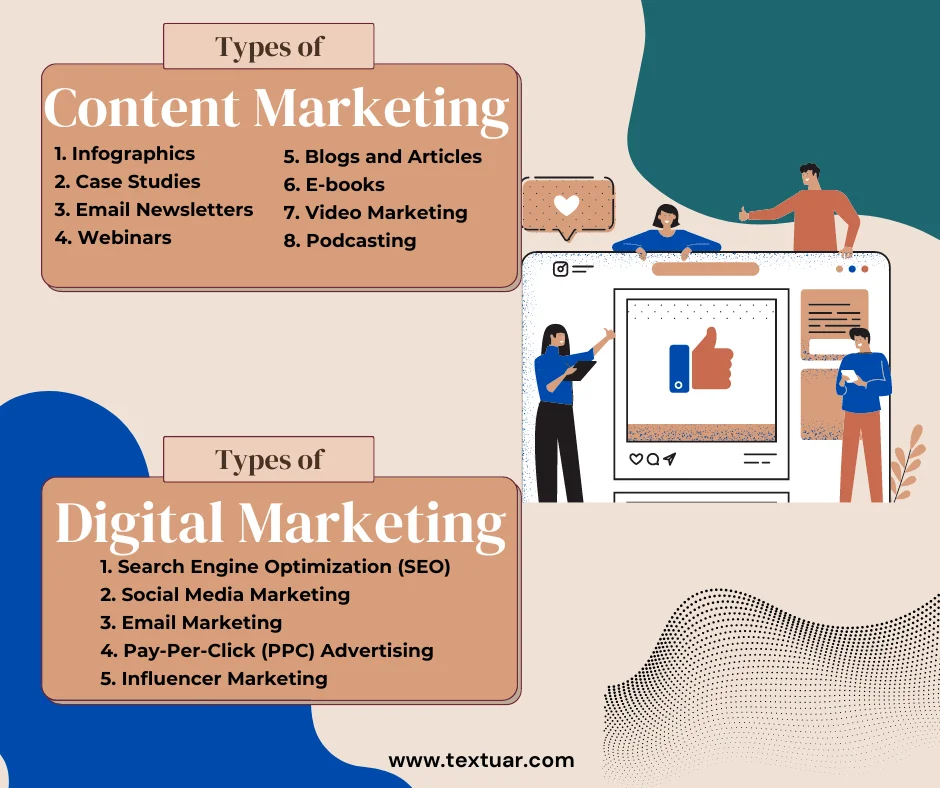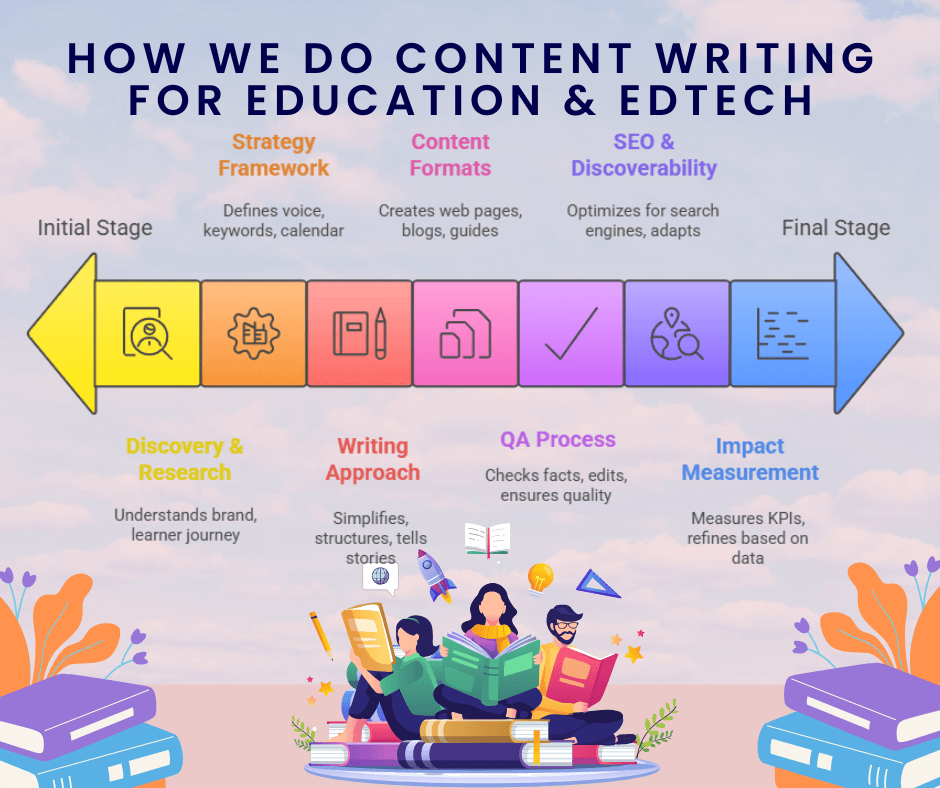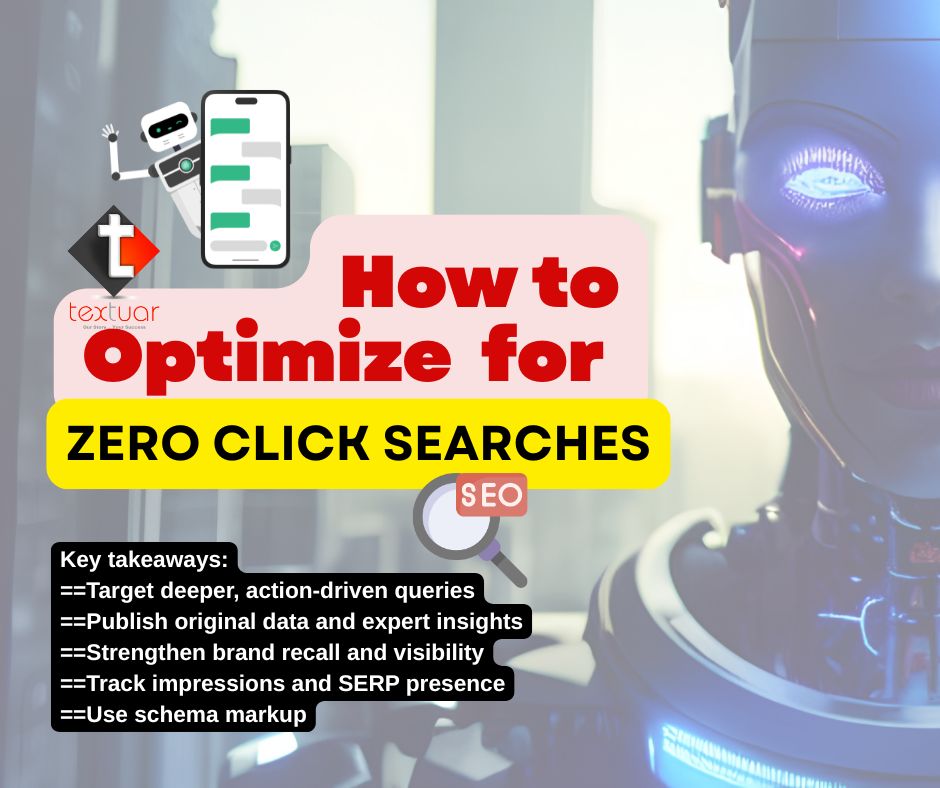In the contemporary online world, marketing holds immense significance for a brand to reaching out and engage with target consumers. It plays a pivotal role in attracting audiences, nurturing trust, and driving sales.
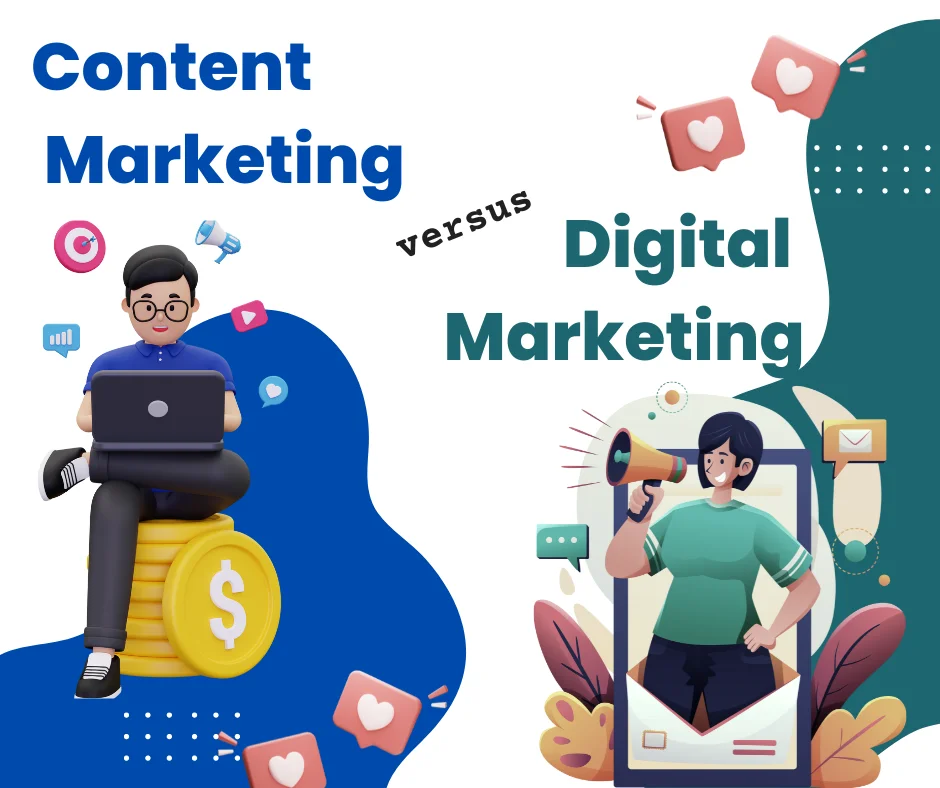
To foster the growth of your company, it becomes imperative to leverage content marketing and digital advertising strategies. Besides, these strategies can effectively help you reach your target market, enhance lead generation, and ultimately increase sales.
Takes these interesting stats, for better context –
- 60% of all marketing is digital marketing.
- The amount spent on advertising in India would rise by nearly 20000 crores, or 15.5%, from 2022 to 2024.
- The Content Marketing Institute estimates that 73% of B2B and 70% of B2C marketers implement content marketing as a component of their general marketing plans.
These stats give an overall picture that content marketing and digital marketing are two well-known tactics that have garnered much popularity.
If you have done business online, you might have frequently heard these two terms: content marketing and digital marketing. They are combined so often that they can be mistaken for one. However, it is important to note that they are distinct from each other.
You may enhance marketing and advertising efforts by developing plans for each. And understanding how they vary will also make a difference.
This article aims to explore the variations between marketing and advertising, empowering you to make an informed decision that aligns with your specific marketing goals and objectives.
An Overview of Content Marketing
The main focus of content marketing is to draw in and keep the attention of the intended target audience. The development and dissemination of excellent and pertinent information is carried out in this form of marketing.
Instead of advertising goods or services, content marketing focuses on delivering valuable and meaningful content.
Consider the below example to comprehend content marketing’s practical use.
A leading e-commerce platform in India specializing in fashion and lifestyle products executed a highly impactful content marketing campaign. The primary goal of this campaign was to establish the brand as the go-to fashion guidance and inspiration source for Indian consumers.
To do this, the business devised a content marketing strategy. It was focused on producing insightful and interesting fashion-related content. The platform established a dedicated blog section on its website. This section became a hub for regularly publishing articles, how-to guides, and trend reports.
In order to ensure the authenticity and appeal of the blog’s content, the organization collaborated with fashion influencers and industry professionals. This strategic partnership allowed for the creation of genuine and captivating content that resonated with the target audience. They discussed a range of subjects, including fashion hacks, seasonal trends, style advice, and celebrity-inspired outfits.
Now that you know what content marketing is, let’s understand the aspects of digital marketing below.
An Overview of Digital Marketing
Digital marketing refers to a wider range of tactics that goes beyond content. It involves the use of various internet platforms and technology to advertise goods and services. SEO, social media marketing, email marketing, and various strategies are used in this process.
Let’s explore digital marketing in more detail using an actual case.
Digital marketing methods were effectively applied by a well-known online meal delivery service to raise brand awareness. With these methods, they also grew their clientele and spurred sales. They improved their website and content for relevant keywords to rank top in search engine results. The efforts eventually boosted the brand’s natural visibility and drew in more niche traffic.
This meal delivery business worked with food bloggers and influencers from various cities to produce sponsored content. They produced interesting and aesthetically pleasing content pieces to connect with their audience. Updates and marketing campaigns were shared on Facebook, Instagram, and Twitter.
The firm drove more traffic to its website due to its digital marketing activities. Higher engagement rates were produced through the company’s social media activities, including likes, comments, shares, and user-generated content. Conversions significantly increased due to the combination of efficient digital marketing techniques. Ultimately more orders were placed on their platform later on.
As we better understand both terms in detail, let’s discuss their distinct features.
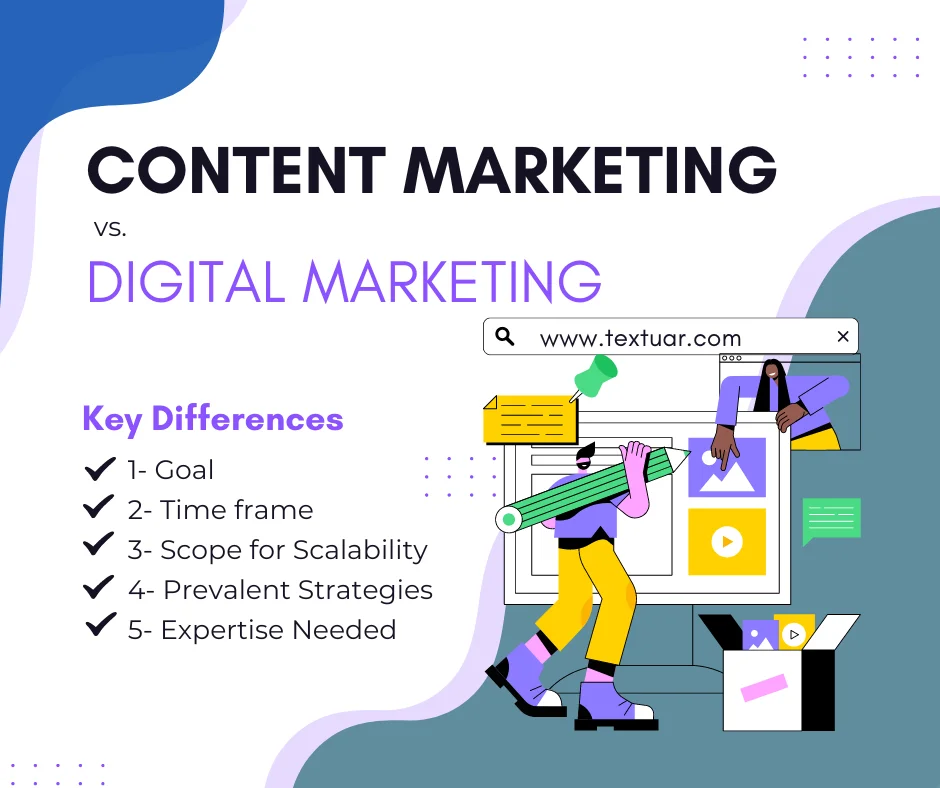
Key Differences Between Content Marketing and Digital Marketing
1- Goal
Content Marketing: Content marketing aims to produce and distribute helpful and relevant data that will improve brand awareness and exposure. 70% of B2C marketers believe that brand recognition is a crucial objective in their content marketing efforts, according to a poll by the Content Marketing Institute.
Content marketing positions an agency or an individual as a respected leader in their field. And this is why 96% of B2B customers prefer content from experts in their fields. Also, content marketing seeks to engage and nurture current clients by continuously distributing quality information. According to a Loyalty360 survey, 80% of consumers are more inclined to purchase businesses that offer unique content.
Digital Marketing: Digital marketing’s primary objective is to attract and gather leads by targeting potential consumers who have shown interest in a product or service through digital channels. The State of Inbound research indicates that 69% of companies place the conversion of leads into customers as their top marketing objective.
Through advertising goods or services on various online platforms, companies seek to have an impact on consumer choices and increase sales. Global e-commerce sales are expected to exceed $5.2 trillion by 2021, according to Statista. It clearly emphasizes the importance of digital marketing in generating revenue.
2- Time frame
Let us move forward with our next point- Time frame. The length of time needed to see the effects of content marketing and digital marketing may depend on a number of variables used. Here is a comparison supported by fitting data:
Content Marketing: With a long-term approach, content marketing focuses on developing connections. The contents are utilized to target audiences by providing them with relevant information. An audience often takes time to build. Forming a bridge between audience and content can help you build credibility and get noticeable outcomes.
The Marketing Insider Group estimates that it typically takes firms 4 to 5 months to notice a prominent boost. The boost is a result of their content marketing initiatives that give website traffic and conversions.
Digital Marketing: On the other side, digital marketing provides more immediate and quantifiable outcomes. Businesses may see results in lead generation, sales, and website traffic very quickly by using focused online advertising and search engine optimization. According to a Smart Insights poll, 45% of marketers claimed to have seen favorable outcomes just six months after introducing digital marketing methods.
It’s crucial to remember that these figures only serve as broad guidelines; individual outcomes may differ. Consistent efforts, high-quality content, audience targeting, and continuing optimization are required for content marketing and digital marketing to succeed.
3- Scope for Scalability
Content Marketing: Campaigns for content marketing are naturally scalable and adaptable. Content marketing methods’ flexibility also enables companies to interact with the audience. You can reach the target demographic through social media, email newsletters, guest blogging, and content collaborations.
The scalability of content marketing comes from your capacity. You should consistently have interesting content to provide. You can simultaneously adjust to shifting customer tastes and market trends.
Digital Marketing: Due to the enormous variety of channels and audience groups available, digital marketing tactics are very scalable and adaptive. Companies may grow their digital marketing initiatives by focusing on new platforms.
You can shift from search engine advertising to social network or mobile app advertising. Businesses may adjust their marketing strategies in response to consumer behavior.
Both tactics’ scalability and versatility allow firms to reach a wider audience and focus their marketing efforts on the best outcomes.
4- Prevalent Strategies in content marketing and digital marketing
Techniques for content marketing
4.1- Blogging: According to HubSpot, companies that prioritize blogging are 13 times more likely to see a profit. Compared to businesses without active blogs, active blog businesses generate 67% more leads per month.
4.2- Video marketing: 87% of firms said that video marketing boosted the number of visitors to their websites. Additionally, video content has assisted them in generating leads.
Tactics for digital marketing:
4.3- Social Media Advertising: Budgets for social media advertising have reportedly risen globally during the previous two years, according to Hootsuite. Particularly, Facebook advertising reaches 2.8 billion active users each month, making it a powerful platform for targeted efforts.
These figures show how certain content marketing strategies, as well as digital marketing strategies, may help firms increase engagement, conversions, and ROI.
5- Expertise Needed
Content Marketing: Strong communication and writing abilities of experts can assist you in producing interesting and intriguing information. Creating a strategic approach for content development and delivery (content strategy and planning), too helps.
Understanding search engine optimization strategies can help you increase the visibility of your content. Analyzing content performance and interpreting data will create data-driven decisions.
Digital Marketing: Get knowledge of platforms like Google Ads, Facebook Ads, and programmatic advertising for digital advertising. Understanding social media platforms, content production, and community management are all part of social media marketing.
The capacity to monitor and evaluate can improve the effectiveness of a campaign using software like Google Analytics. You can try out various tactics to increase the success of a campaign with A/B Testing.
The need for content marketing professionals has increased by 69% annually. Statista estimates that global spending on digital advertising will reach $398 billion by 2023 in the field of digital marketing. This demonstrates significant development potential and the growing demand for qualified individuals.
Types of Content Marketing
1. Infographics
Infographics are excellent for simplifying data and capturing audiences on social media platforms. They graphically depict complicated facts and statistics.
2. Case Studies
Case studies showcase real-life scenarios of how a product or service resolves a customer’s issue. These studies help to establish credibility and trust with new clients.
3. Email Newsletters
Email newsletters deliver worthwhile information straight to subscribers’ inboxes. You can generate them with current news and special deals. Such updates retain engagement and foster brand loyalty.
4. Webinars
Webinars provide instructional sessions. This content form allows businesses to share industry expertise. They encourage attendees’ interaction and create leads by collecting contact information during registration.
5. Blogs and Articles
Through search engine optimization and content marketing, blogging enables companies to share their knowledge. With industry insight and thought leadership, you generate organic traffic to your website.
6. E-books
E-books are efficient lead-generating tools. They offer in-depth knowledge and priceless resources in return for contact information. They also develop leads by providing benefitting content and credibility.
7. Video Marketing
Using video marketing to entertain and engage viewers is effective. It grabs their attention and delivers strong messages. Businesses may use it to demonstrate products. You can deliver instructions and tell tales to amuse your audience via visual and aural experiences.
8. Podcasting
Use podcasts to deliver insights and interviews. Generating conversations in podcasts helps businesses establish themselves as subject matter. A business can portray itself as a field expert and develop a loyal audience. It fosters a sense of connection and community by delivering excellent content that can be discovered on the go.
Types of Digital Marketing
1. Search Engine Optimization (SEO)
SEO improves organic search visibility and website traffic. It optimizes website content and meta tags. Using keywords tactically is another SEO technique to enhance user experience. Highly targeted SEO campaigns aim to rank higher on search engine result pages.
2. Social Media Marketing
Social media marketing leverages platforms like Facebook and Instagram to engage with audiences. You can even use Twitter for brand awareness and website traffic. It involves creating compelling content and running targeted ads. Fostering community engagement is also adaptable to increase brand visibility and customer engagement.
3. Email Marketing
Email marketing enables companies to send personalized messages. It helps nurture leads and build customer relationships. It involves creating targeted email campaigns. The business delivers relevant content using automation to send timely and personalized messages.
4. Pay-Per-Click (PPC) Advertising
PPC advertising targets specific keywords and demographics to display ads on search engine result pages. Businesses pay only when users click on their ads. This enables target reach and immediate results. It is effective for generating leads and promoting specific products or services.
5. Influencer Marketing
Influencer marketing partners with influential individuals or social media personalities. It is to promote products or services. Businesses can tap into their target audience by leveraging their reach and credibility. You can also benefit from authentic recommendations, increasing brand visibility, trust, and conversions.
These digital marketing techniques serve specific purposes. They can be combined to create comprehensive and effective marketing campaigns tailored to the business goals and target audience.
Harnessing the Synergies of Both Digital and Content Marketing
Integrating content marketing with digital marketing tactics provides several benefits by harnessing the capabilities of each method.
Content marketing offers interesting, useful, and engaging information. Drawing in and instructing the audience is simple with this marketing use. The content promotes thought leadership and strengthens the reputation of the business.
On the other hand, digital marketing makes use of a variety of platforms. Social media marketing (SMM), search engine marketing, and email marketing are commonly used outlets. Forming a connection with viewers and targeting particular consumer groups is achievable with digital marketing. You can additionally increase traffic and leads with its individual use.
What could you do by implementing both?
- Businesses may boost audience engagement by distributing great content through digital platforms.
- Next, you can improve marketing efficacy by utilizing data-driven insights. Raising brand awareness by merging the two is an unbeatable strategy plan.
- A compelling and comprehensive strategy that optimizes reach and engagement eventually leads to corporate success.
The synergy between content marketing and digital marketing ensures all of these.
Tools Used for Content Marketing
- Content Management Systems (CMS): CMS tools like HubSpot, Drupal, and WordPress make creating and publishing content easy. To simplify content workflows, they provide user-friendly interfaces. You even get editable templates and collaborative tools.
- SEO Tools: Tools like SEMrush and Moz help with content optimization for search engines. They assist companies in increasing organic search exposure. On-page SEO recommendations and backlink analysis are among the top features provided.
- Analytics Platforms: Google Analytics and Adobe Analytics provide information on how well content performs. You get to know how audiences behave and how to measure conversions. Businesses can evaluate the success of their content marketing initiatives and make data-driven choices.
Tools Used for Digital Marketing
- Social Media Management Tools: Social media management tools make planning, scheduling, and tracking social media initiatives easier. Examples include Hootsuite, Buffer, and Sprout Social. They facilitate audience management and content circulation across several social channels.
- Email Marketing Software: Organizations may create and automate email marketing campaigns. It makes tracking easy using tools from Mailchimp and Constant Contact. These platforms offer tools for managing lists, segmenting audiences, personalizing content, and measuring performance.
Your Final Choice Summary
Digital marketing and content marketing are both effective tactics with unique traits. Content marketing focuses on producing informative and entertaining content to increase brand visibility and loyalty. Digital marketing employs different internet platforms to generate leads and increase revenue.
Evaluating the goals, target audience, resources, and skills is essential when deciding on the best course of action. To make an informed choice that suits your company’s demands and enhances marketing performance, consider your objectives and available resources.
If you’re searching for a trusted content writing agency to boost your revenue, consider partnering with Textuar. Our agency specializes in creating revenue-packed content that resonates in the global market. For pricing details and additional information, please visit our website. Discover the potential of revenue-generating content by connecting with us today!

